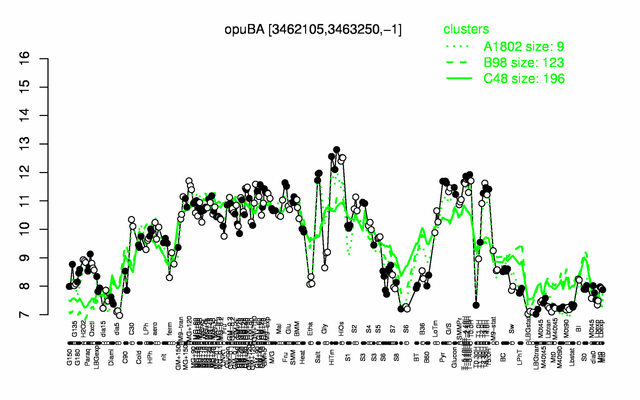OpuBA
- Description: choline ABC transporter (ATP-binding protein)
| Gene name | opuBA |
| Synonyms | proV |
| Essential | no |
| Product | choline ABC transporter (ATP-binding protein) |
| Function | compatible solute transport |
| Gene expression levels in SubtiExpress: opuBA | |
| Interactions involving this protein in SubtInteract: OpuBA | |
| Metabolic function and regulation of this protein in SubtiPathways: opuBA | |
| MW, pI | 42 kDa, 5.654 |
| Gene length, protein length | 1143 bp, 381 aa |
| Immediate neighbours | opuBB, yvaV |
| Sequences | Protein DNA DNA_with_flanks |
Genetic context 
This image was kindly provided by SubtiList
| |
Expression at a glance PubMed
| |
Contents
Categories containing this gene/protein
ABC transporters, coping with hyper-osmotic stress, membrane proteins
This gene is a member of the following regulons
GbsR regulon, OpcR regulon, RemA regulon
The gene
Basic information
- Locus tag: BSU33730
Phenotypes of a mutant
Database entries
- BsubCyc: BSU33730
- DBTBS entry: no entry
- SubtiList entry: [1]
Additional information
The protein
Basic information/ Evolution
- Catalyzed reaction/ biological activity:
- Protein family: ABC transporter family (according to Swiss-Prot)
- Paralogous protein(s): OpuCA
Extended information on the protein
- Kinetic information:
- Domains:
- Modification:
- Cofactor(s):
- Effectors of protein activity:
- Localization: associated to the membrane (via OpuBB-OpuBD) PubMed
Database entries
- BsubCyc: BSU33730
- Structure:
- UniProt: Q45460
- KEGG entry: [2]
- E.C. number:
Additional information
Expression and regulation
- Regulatory mechanism:
- Additional information:
- number of protein molecules per cell (minimal medium with glucose and ammonium): 42 PubMed
- number of protein molecules per cell (complex medium with amino acids, without glucose): 109 PubMed
- number of protein molecules per cell (minimal medium with glucose and ammonium, exponential phase): 215 PubMed
- number of protein molecules per cell (minimal medium with glucose and ammonium, early stationary phase after glucose exhaustion): 271 PubMed
- number of protein molecules per cell (minimal medium with glucose and ammonium, late stationary phase after glucose exhaustion): 161 PubMed
Biological materials
- Mutant:
- Expression vector:
- lacZ fusion:
- GFP fusion:
- two-hybrid system:
- Antibody:
Labs working on this gene/protein
Your additional remarks
References